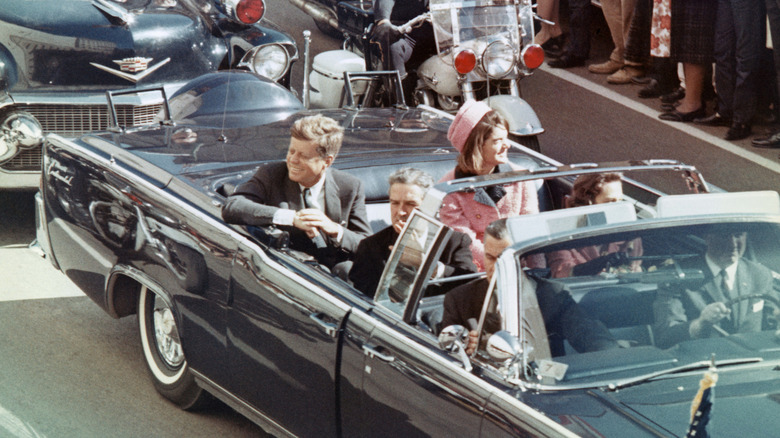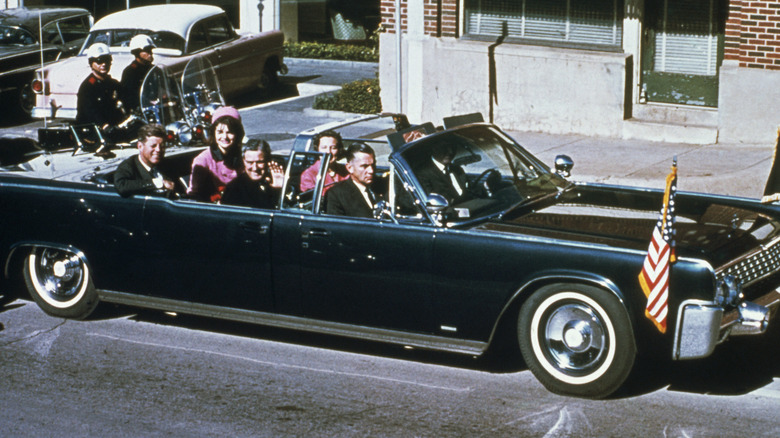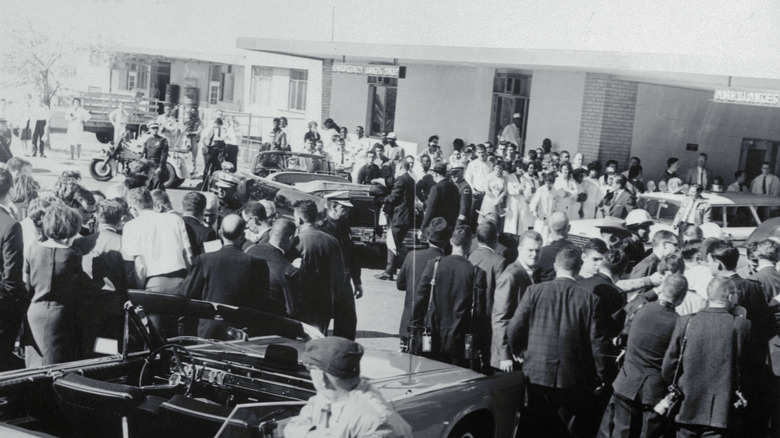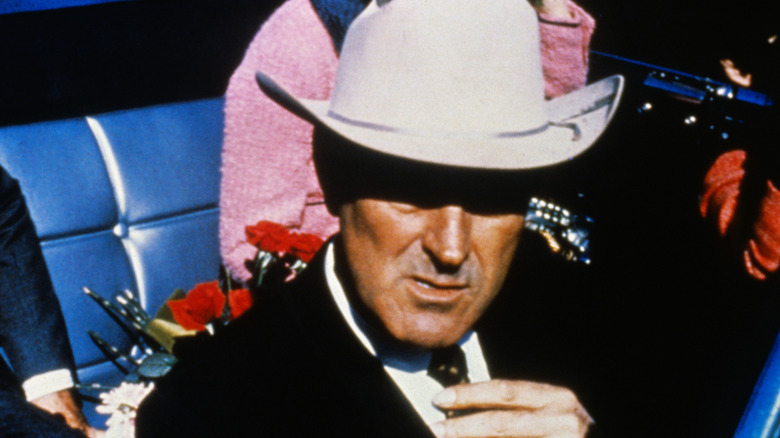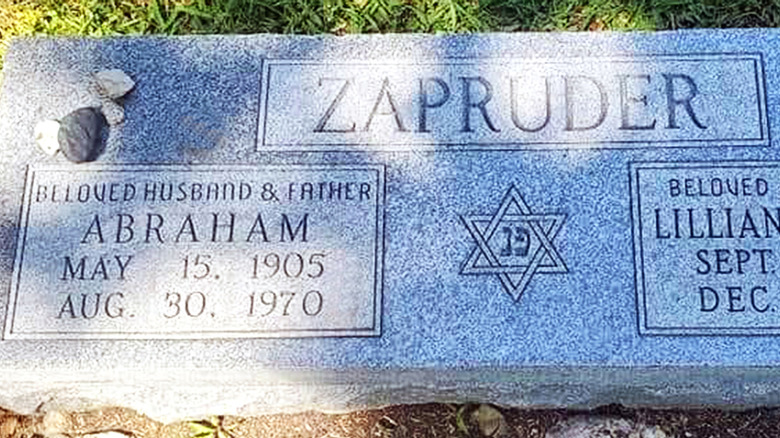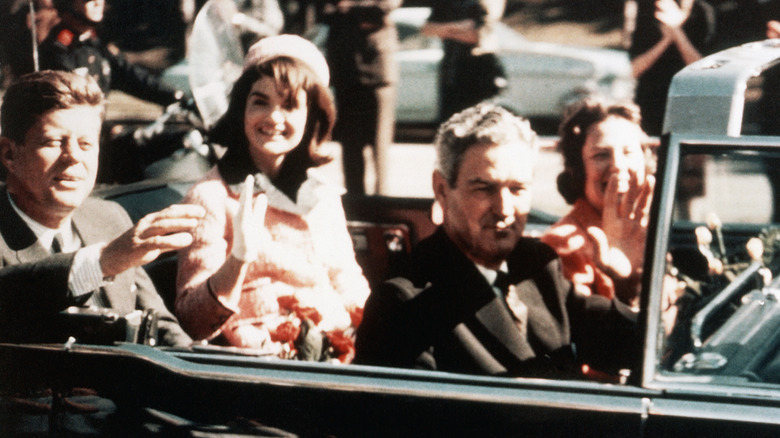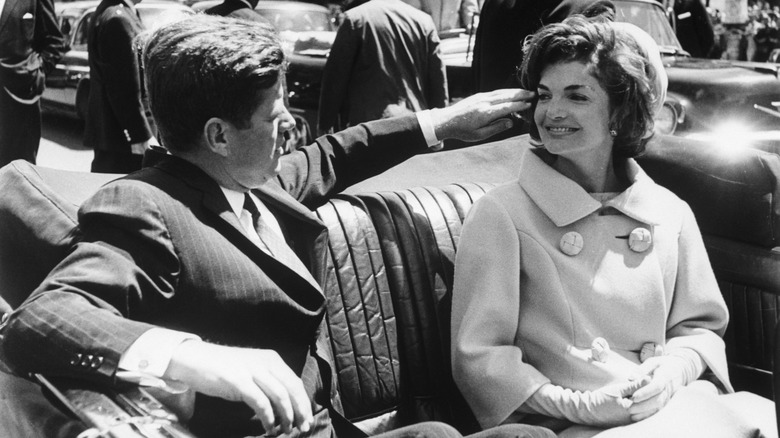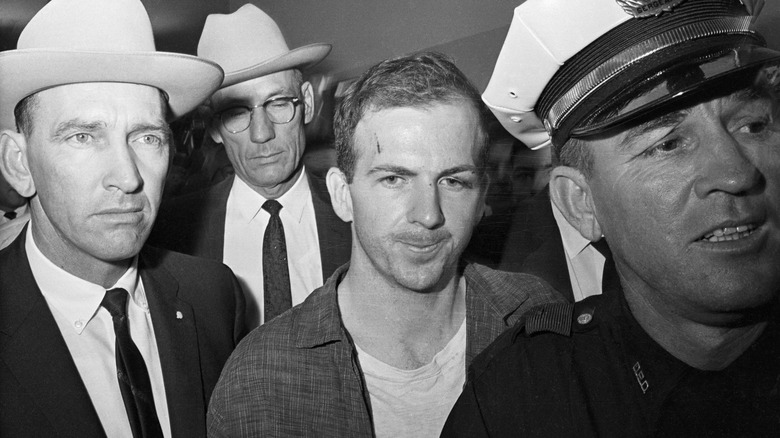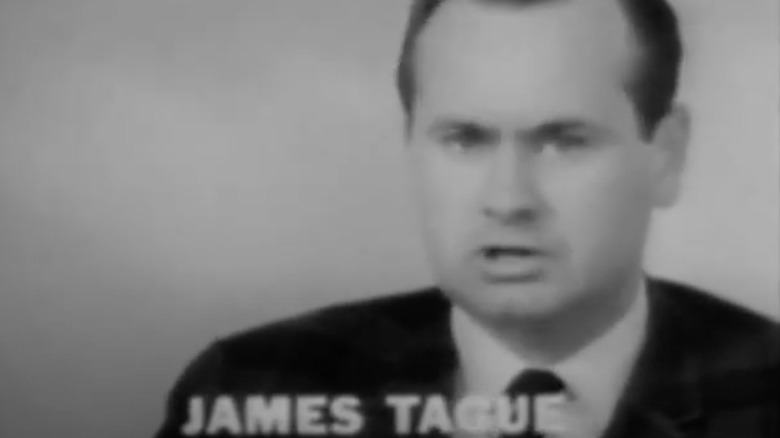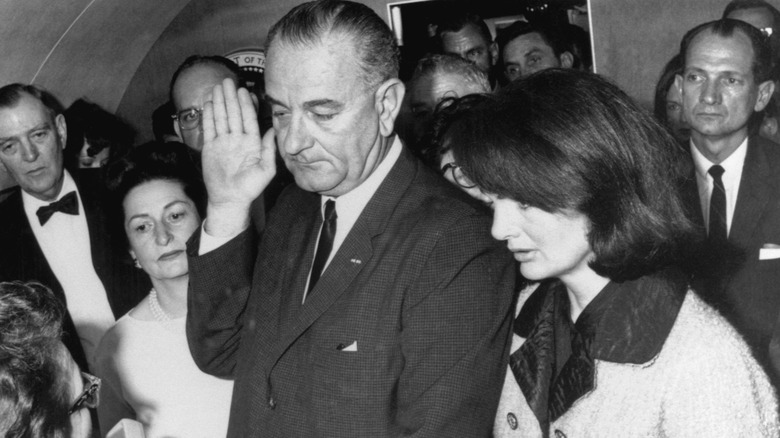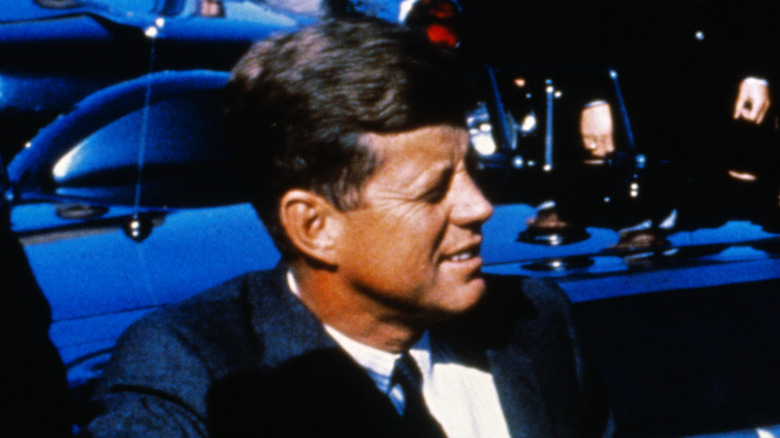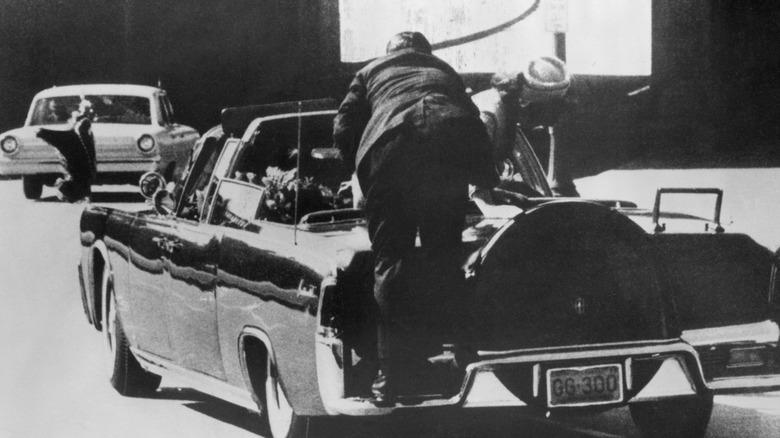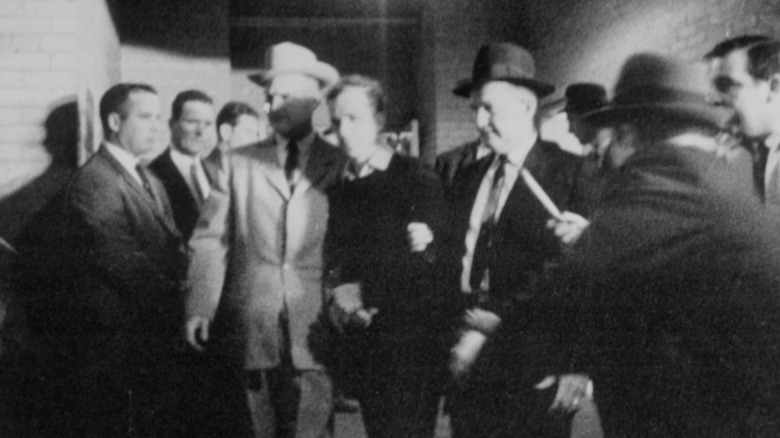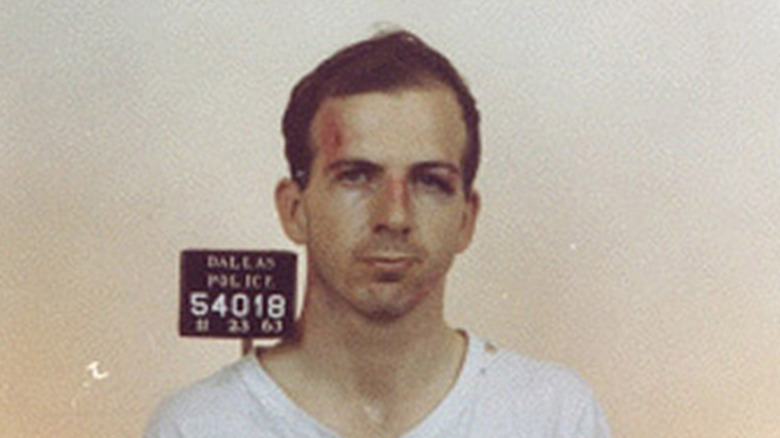Why JFK's Assassination Was Worse Than You Thought
The world changed in an instant when President John F. Kennedy was shot and mortally wounded during a visit to Dallas. A definitive, pivotal, and transformative moment in American history, it arguably resulted in the loss of some theoretical American innocence and kicked off the tumult and upheaval of the 1960s. Still, people wanted and needed to make sense of what appeared to be a senseless event — Lee Harvey Oswald's heinous act lent some credence to the idea of the Kennedy curse, and also resulted in myriad conspiracy theories that persist to the present day.
As the Kennedy assassination drifts further into the past with each passing year, the details of it grow hazier and more poorly defined. Here are all the ways that the assassination of President John F. Kennedy was more horrendous than the history books and our collective memory would suggest.
There was a missing bullet
Secret Service Agent Paul Landis worked as first lady Jacqueline Kennedy's security detail, and he was acting in that capacity when he traveled with the presidential motorcade through Dallas on the day that President John F. Kennedy was fatally gunned down. After witnessing the murder and the president's arrival at the emergency wing of Parkland Memorial Hospital, Landis surveyed the automobile and scene of the crime, and noticed a spent bullet on the seat where Kennedy had been sitting. Landis, technically tampering with evidence, grabbed the bullet and placed it in his pocket. After entering the emergency room, he placed the bullet on the gurney holding the dying president, theorizing that it should travel with the body.
Landis was never interviewed by the assassination-investigating Warren Commission, and he never publicly disclosed his story about pilfering the bullet until 2023, with the publishing of his memoir, "The Final Witness." He'd simply forgotten to mention it to anyone.
The hospital where the president was treated was inundated with prank calls
Documentaries, books, and films examining the cultural mood surrounding the assassination of John F. Kennedy in 1963 suggest a time of universal sadness and somberness as a traumatized nation breathlessly followed news reports and then grieved together as one. This emerged as the prevailing narrative in retrospect, because after the president of the United States was shot multiple times as he rode in a car through downtown Dallas, and up to the moment he died and after, the hospital where he was treated for his mortal wounds received a large volume of prank and threatening phone calls.
While the Army Signal Corps took control of Parkland Memorial Hospital's outgoing phone lines, the hospital's switchboard operators were tasked with fielding the calls that came in at a rapid clip and dutifully logging each one. Callers from as far away as Europe, Australia, and South America demanded more information, falsely claiming to be very important people. One woman gave her identity only as "The Underground," and she'd called to offer up her supernatural powers to heal President Kennedy. One man told the operator that he planned to blow up her car; others blamed Kennedy's assassination on his support for the Civil Rights Movement. One boy managed to call in three times, reaching three different operators. Each time, he claimed to be Kennedy's young son and then laughed and hung up.
Another politician was almost assassinated that day
President John F. Kennedy wasn't riding alone in that open-topped car in Dallas that day in November 1963. While he rode with his wife, first lady Jacqueline Kennedy, in the back, Kennedy's friend, Governor John Connally of Texas, sat in the middle row of the vehicle. He heard a shot, instantly realized it was the sound of a cartridge discharged from a rifle, and looked across his right shoulder to see if Kennedy was alright. Connally couldn't see what exactly had happened, so he started to turn to his left, at which point he felt a bullet enter his body. It traveled from his collarbone and through his chest and came to rest in his left leg, slightly above his knee.
The bullet pierced one of the governor's lungs, and he required a four-hour operation to remove it and repair the damage. He fully recovered from his injuries, which also included rib fractures and a shattered wrist. It could have been a lot worse for Connally, had he not moved the way he did. "If he had not turned, the bullet would have gone through the middle of his back and probably would have punctured his heart," attending physician Dr. Tom Shires told UPI the day after the shooting.
Abraham Zapruder was traumatized
Every major authorized investigation into the assassination of President John F. Kennedy, and most of the ones undertaken by amateur detectives and conspiracy theorists, has used the same historical document as a starting point: a 26.6-second piece of eight-millimeter film captured by hobbyist photographer Abraham Zapruder. It's the only moving visual media of the tragic events of November 22, 1963, and it captures in excruciating detail the murder of the president.
Zapruder stood in a spot in Dealey Plaza where he was able to get a clear view of the presidential motorcade. But when shots were fired, it also made Zapruder a direct and primary witness. "I saw the president lean over to Jacqueline, then the second shot came and then I realized I saw his head open up and I started yelling, 'They killed him, they killed him,' and I continued shooting until they went under the underpass," Zapruder told reporter Marvin Scott (via PIX 11).
That moment deeply and negatively impacted Zapruder's mental health. "It's left in my mind like a wound that heals up but yet there's a pain left as to what has happened," he said. His camera was seized by the government and now sits in the National Archives. He was given a new camera, but he never touched it nor any other camera ever again, because it brought back too many horrible memories of the assassination.
One bullet did a lot of the damage
According to investigations and the Warren Commission, Lee Harvey Oswald is the sole person responsible for the assassination of President John F. Kennedy in Dallas on November 22, 1963. From his position in an upper level of the Texas School Book Depository Building, the former U.S. Marine acted like a sniper and unloaded three rifle shots at the presidential motorcade. The third and final shot is the one that explosively struck Kennedy in the head, ultimately the fatal blow.
But the second bullet from Oswald's rifle did a substantial amount of damage, tearing through both the president and his riding companion, Texas governor John Connally. That bullet entered Kennedy through his back and then exited through the neck. It continued to travel, striking Connally near his armpit. It then traveled through his chest and body, injuring his wrist before stopping in his thigh.
The president's back problems may have aided his death
President John F. Kennedy suffered from back issues for most of his adult life, even undergoing multiple surgeries that proved unsuccessful in alleviating the near-constant pain. When making public appearances for his various presidential duties, Kennedy wore a back brace that was more like a corset. It covered his hips in addition to the majority of his back and was laced extremely tightly; all of that was then wrapped in a constricting fabric bandage. The system kept everything in place and thereby limited pain, but it also seriously restricted Kennedy's movements.
The corset prevented even natural, involuntary movements, and that may have been a contributing factor to Kennedy's death on November 22, 1963. He was wearing the apparatus under his clothes while he rode in a limousine through Dallas. After he was shot the first time, his body likely would have recoiled, hunched over, and fell to the floor of the car, had the president been unencumbered by medical undergarments. Instead, his body remained upright in the seat, giving Lee Harvey Oswald a clear path to deliver another, fatal gunshot to his head.
It wasn't an isolated murder for Lee Harvey Oswald
Despite the insistence of numerous conspiracy theories developed, spread, and analyzed over the last six decades, the prevailing wisdom and official account of the assassination of John F. Kennedy points toward Lee Harvey Oswald, one of the most dangerous assassins in history, as the single culprit responsible. Oswald murdered the president of the United States in November 1963, but it wasn't the first time he premeditated such a heinous crime, nor would Kennedy be his last victim. In April 1963, Oswald, an avowed communist, located the home of outspoken anti-communism critic and retired U.S. Army general Edwin Walker, and made an assassination attempt. His shot hit a windowsill rather than the intended target. Only after the Kennedy assassination was Oswald linked to this case, because he'd used the same rifle in both crimes.
About 45 minutes after Oswald shot President Kennedy, he was stopped by a Dallas police officer, J.D. Tippit. Oswald fit the description of the shooting suspect given to police. Tippit stopped his patrol car next to an on-foot Oswald, and after engaging in conservation for a moment, Tippit got out of his car. Oswald shot him at close range with a handgun, three times in the body and then once, fatally, in the head.
An innocent bystander was injured
One horrifying detail about the Kennedy assassination concerns the collateral damage. Obviously, Lee Harvey Oswald intended to shoot and kill President John F. Kennedy, and he additionally landed a shot on Governor John Connally that resulted in serious wounds. One more individual nearly died at Oswald's hand on November 22, 1963, and it was someone who had no connections to politics or the other victims.
James Tague, a 27-year-old Dallas car salesman, arrived at Dealey Plaza just as the presidential motorcade was winding through the area. Late for a lunch appointment, Tague parked his car to get out to see why crowds had gathered. Mere seconds later, as he remembered seeing a news article about Kennedy's visit, he heard a popping sound of what he thought was a firecracker. Then he noticed the distinctive sound of two rifle shots. "And with those last two shots I felt something sting me in the face," Tague told the BBC. He ran for cover behind an underpass pylon, and after seeing the motorcade drive away and speaking with two police officers who noticed blood on his face, Tague pieced together what had happened: He had been struck by a piece of curb that flew into the air, dislodged by one of Oswald's bullets.
Everything happened within a very small window of time
The events of November 22, 1963, loom very large in the story of the United States. The first presidential murder in more than 60 years, occurring during a time of relative peace and prosperity, unnerved a nation, and it was an assassination that changed the course of history. What's surprising and shocking about what happened in Dallas that day is that the timeline of JFK's assassination is very short.
President Kennedy's plane, Air Force One, touched down at Dallas' Love Field airport at 11:30 a.m., and the first couple were greeted by the media and well-wishers. By 11:45 a.m., John and Jacqueline Kennedy, along with Texas governor John Connally, vice president Lyndon Johnson, and their spouses, had been loaded into an open-topped car bound for Dealey Plaza in downtown Dallas. The motorcade reached its destination at 12 p.m., slowly driving through the streets lined with more than 150,000 locals who wanted to get a glimpse at the president. At 12:30 p.m., shots were fired, hitting Kennedy and Connally. Rushed to Parkland Memorial Hospital and into surgery, Kennedy was pronounced dead one hour and three minutes later. And just 12 minutes after that, suspected gunman Lee Harvey Oswald was arrested in a movie theater. At 2:38 p.m., Vice President Johnson, whom the Kennedys couldn't stand, was sworn in as president of the United States onboard Air Force One during a flight back to Washington.
JFK didn't immediately die
As seen by probably everyone who cares to see it, the 1963 assassination of John F. Kennedy was documented in real time on an eight-millimeter film reel taken by Dallas resident Abraham Zapruder. The unflinching footage graphically depicts the president sustaining multiple gunshots to his head and neck, but contrary to popular belief, Kennedy didn't die instantly in that car in Dallas' Dealey Plaza. Instead, his demise was a painfully long and harrowing ordeal for the president and his wife, first lady Jacqueline Kennedy, who sat next to him through the entire attack.
Following the assault, the driver of the presidential vehicle immediately and speedily went to Parkland Memorial Hospital, where President Kennedy was rushed into emergency, potentially life-saving surgery. However, Kennedy's prognosis was never good. He arrived at the medical facility in what was described as a "moribund" state, defined as just near the point of death. Indeed, the president died on an operating table at Parkland.
The moments after the gunshots were grisly, intense, and sad
Since 1960, Clint Hill had worked as a Secret Service agent assigned to first lady Jacqueline Kennedy's security team. He was present for the Dallas trip in November 1963, and after hearing the first shot, he literally jumped into action, mounting the back of the car in an attempt to protect his charge and the president. He was only inches away from John F. Kennedy when the latter endured a fatal, violent shot to the head. Hill forced a panicked Jacqueline Kennedy to remain in her seat, and she held her dying husband's head in her lap. The agent surveyed the substantial, profound injuries to the president and understood that he wasn't likely to survive. According to Hill's memoir "Mrs. Kennedy and Me," the first lady screamed out, "Jack, Jack, what have they done to you?" In the docuseries "JFK: One Day in America" (via People), Hill recalled that she added, "They shot his head off! I love you, Jack."
For decades after the assassination, Hill harbored extraordinary guilt over how the events transpired, horrified and embarrassed that the president had died under his watch. He subsequently developed a drinking problem, isolated himself from family, and contemplated suicide.
If you or anyone you know needs help with addiction issues or is struggling or in crisis. contact the relevant resources below:
- The Substance Abuse and Mental Health Services Administration website or contact SAMHSA's National Helpline at 1-800-662-HELP (4357).
- Call or text 988 or chat 988lifeline.org
The assassin's murder marked a dark milestone
Within hours after the shooting of President John F. Kennedy in Dallas' Dealey Plaza, police arrested the chief suspect — and the man the Warren Commission would determine was the sole assassin, working alone — Lee Harvey Oswald. The legal impact came quickly. Kennedy was killed on November 22, Oswald was arraigned on charges relating to the murders of both the president and Officer J.D. Tippit on November 23, and on November 24, the suspect was in the midst of being transported from Dallas' police headquarters building to a county jail that could provide better security.
Officials and members of the media crowded into the basement as police escorted Oswald through, only for local nightclub owner Jack Ruby to push his way through the onlookers and deliver a single, short-range gunshot from a revolver into the presidential assassin. Oswald would die from his wounds, the victim of the second public and shocking murder in Dallas in just three days. What's especially notable about Oswald's death is that it was unwittingly witnessed live by potentially thousands if not millions of people. TV news crews were part of the throng in the police headquarters basement, and they were broadcasting the Oswald transfer live as it happened, coast to coast. This made his shooting death the first known televised murder in history.
Lee Harvey Oswald was apparently a poor marksman
In 2025, the newly inaugurated President Donald Trump issued an executive order to trigger the public release of any and all still classified government agency documents relating to the investigation of the assassination of President John F. Kennedy. On March 18, 2025, those materials surfaced, and while the newly viewable documents didn't contain much information not previously known to the public, some shed some light on assassin Lee Harvey Oswald's history with the Soviet Union.
While it's common knowledge that he spent some time in the communist nation before the murder of President Kennedy, there have been rumors he was affiliated with the Soviet spy and security office, the KGB. However, one document puts that idea to rest: Dated November 20, 1991, the communique reveals that a KGB agent identified as "Slava" Nikonov went through five extensive files to see if Oswald had ever worked for the secretive agency, then discussed his findings with American college professor E.B. Smith.
Nikonov believed that Oswald wasn't easily manipulated, which was required for a KGB agent at the time. Nevertheless, he was rigorously observed by Soviet personnel, who deemed him useless to the agency because they saw him take some target practice and found the future presidential assassin's skills at shooting to be subpar.
For a look at some of the stranger details surrounding Kennedy's death, read our feature on things that never made sense about JFK's assassination.
